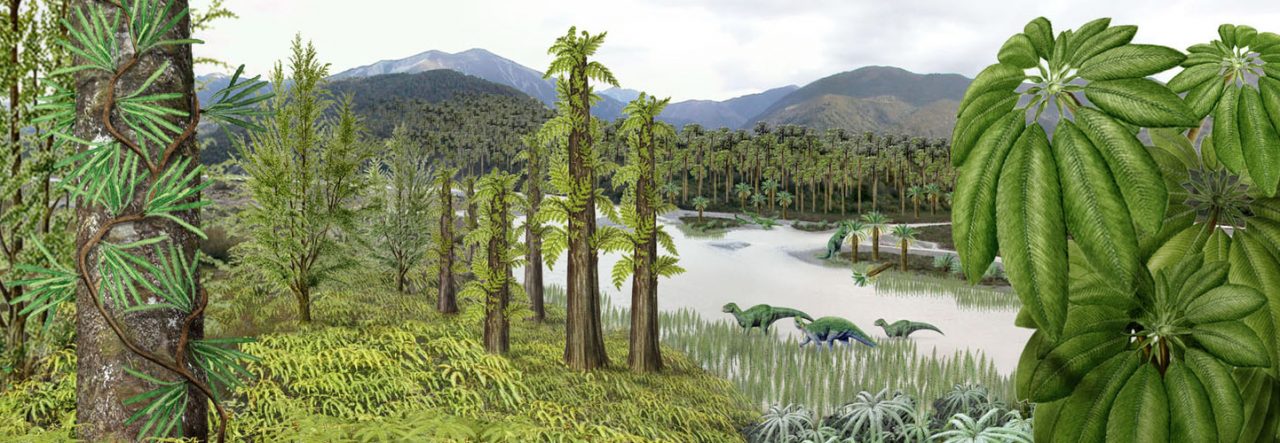Originally published at Lost Worlds Revisited for the Guardian Science Blog Network on 15 March 2017:
The Rhynie Chert fossil deposit in Scotland is just over 400 million years old and reveals secrets of life’s conquest of the land
How life made the move onto land is one of the big questions for palaeobiologists. The physiological challenges were immense, and affected most facets of life. Organisms needed to adapt how they gained water (and prevented themselves drying out), how to obtain nutrients, how to exchange gases with the atmosphere, how to support and move a body without water buoyancy, not to mention reproducing out of water.
Life doesn’t have a grand plan, and terrestrialisation (as the process is known) was a messy, incremental process, with different organisms adapting to life on land at different paces. It’s a bit like going camping with a gang of friends. There will be the keen, pioneering types who like to get there early, set up camp and resolve any problems. Then there’s the late-comers, who roll up with the beer when most of the hard work has been done. The popular image of a lobe-finned fish lolloping up a beach to conquer the land is attractive, but there’s plenty that happened on land before the tetrapods joined the party.
There are clues to the earliest stages in the timeline of the move onto land. Microbial mats had probably been sliming the margins of water bodies since the Precambrian, more than 500 million years ago. Fossil soils (known as palaeosols) from about 460 million years ago suggest that organic matter was being deposited and then recycled by microbes, arthropods were burrowing, and clumps of plants were even stabilising mature soils (but with no direct evidence of the plants themselves). Microfossils preserved in near-shore sediments also tell us that plants were already producing spores (an adaptation to life on land), and dispersed plant tissues show that early land plants had already evolved by that point.

Four hundred million years ago, Scotland was sitting just south of the Equator, and the upland area that became Rhynie would have looked similar to today’s Yellowstone Park. Hot springs rich in minerals would have dominated the landscape. We know from modern equivalents that the vent pools themselves would have been too hot and alkaline to harbour and preserve life, but as you move away from the vents, out towards cooler, less alkaline (but still inhospitable) geothermal wetlands, you see a sequence of different organisms making the best of an extreme habitat. The wonderful thing about the geothermal setting at Rhynie is that the precipitation of silica from the hot spring water rapidly preserved organisms in life position, and with cellular detail.

Preserved in those precious lumps of chert are everything from bacteria, fungi and algae, to early land plants and their spores, and animals including nematode worms, arachnids, centipedes, springtails, silverfish and harvestmen. The oldest known lungs belong to Palaeocharinus, a spider-like trigonotarbid. Another arachnid, the harvestman Eophalangium, briefly held the record for the world’s oldest known penis. The Rhynie Chert also preserved aquatic arthropods in exquisite detail, allowing the detailed structure of crustacean mouthparts to be studied to below a thousandth of a millimetre. Painstaking work using stacks of images to reconstruct larval crustaceans from the nearby (and contemporaneous) Windyfield Chert has resulted in a remarkable amount of knowledge about life within the hydrothermal waters, as well as above them.

Modern spore-producing plants such as mosses, liverworts and even ferns all have life cycles which alternate between a gametophyte form of the plant, with a single copy of the genome and which produces gametes, and, following fertilization, a sporophyte phase with two copies of the genome, which produces and releases spores, from which the gametophyte emerges… and so on. Sporophyte-phase plants from Rhynie such as Rhynia, Aglaophyton and Horneophyton, with root-like rhizoids and naked branching axes (leaves had yet to evolve) were first described a hundred years ago. Remarkably, their equivalent gametophyte forms have all also been identified. In modern spore-producers the emphasis is either on the gametophyte phase (in mosses and liverworts) or on the sporophyte phase (in ferns) but in the Rhynie ecosystem, both phases were independent, free-living plants of similar complexity. This could mean that the Rhynie plants are the sister group to modern vascular plants, the group which includes the ferns and all other ‘higher’ plants with water-conducting tissues.

Rapid preservation in mineral-rich fluid has even captured near-impossible moments in a plant life cycle: the release of sperm cells from the male gamete (antheridium) from the gametophyte form of Aglaophyton, known as Lyonophyton. The details of intimate interactions between early plants and other organisms are also captured: mycorrhizal fungi living in symbiosis inside the plant tissues, 400 million years ago, can be discerned.
The biggest and most complex plant from the Rhynie Chert, Asteroxylon mackiei, almost has leaves. The plant resembles a modern clubmoss, but its leaf-like structures do not have any of the plumbing expected of true leaves and neither do its root-like rhizoids. Asteroxylon does, however, have water-conducting tissues in its stems, and the beautiful cross-sections found in thin sections of Rhynie Chert look uncannily like those of modern clubmosses.

One question which remains after a hundred years of Rhynie Chert research is how typical the ecosystem is for the Early Devonian, 400 million years ago. Hydrothermal wetlands are highly specialised ecosystems today, and a comparison with plant spores found in other rocks of equivalent age suggests that the Rhynie plants may represent the hardcore subset of pioneering early land plants which could survive in such a challenging environment. Exciting experimental molecular work with the modern equivalents to the Rhynie plants (such as the liverwort Marchantia and the moss Physcomitrella) is approaching the same question from the opposite direction: which genes which have been conserved in these plants are key to understanding how they adapted to life on land.
